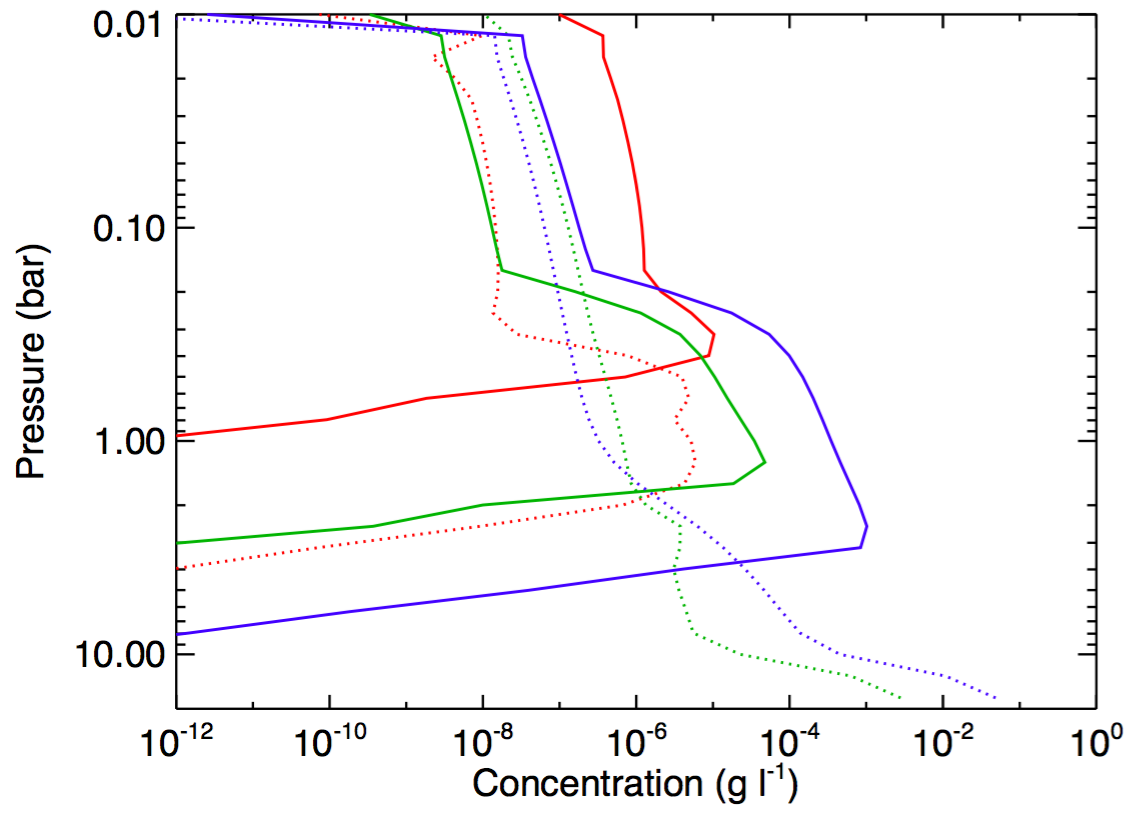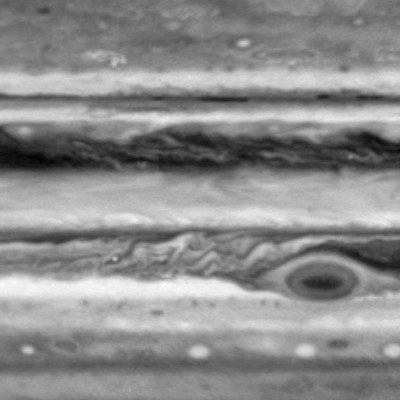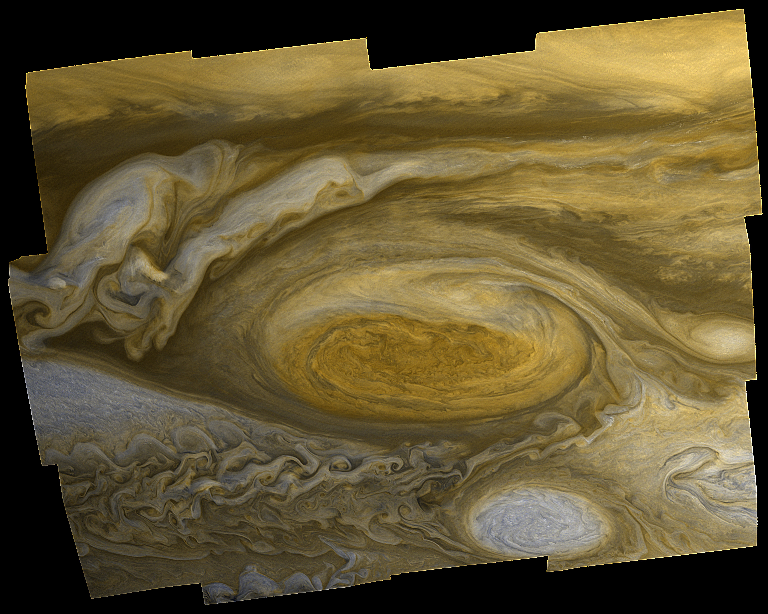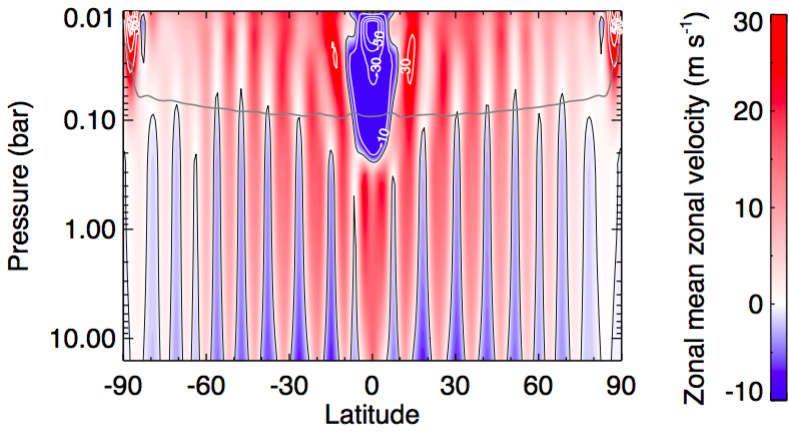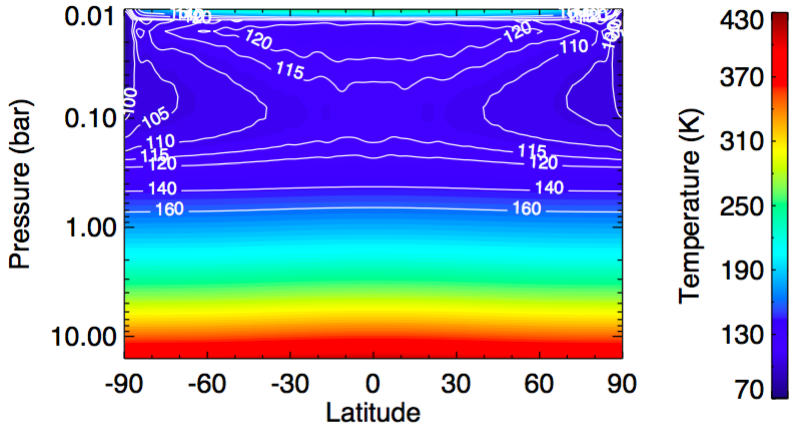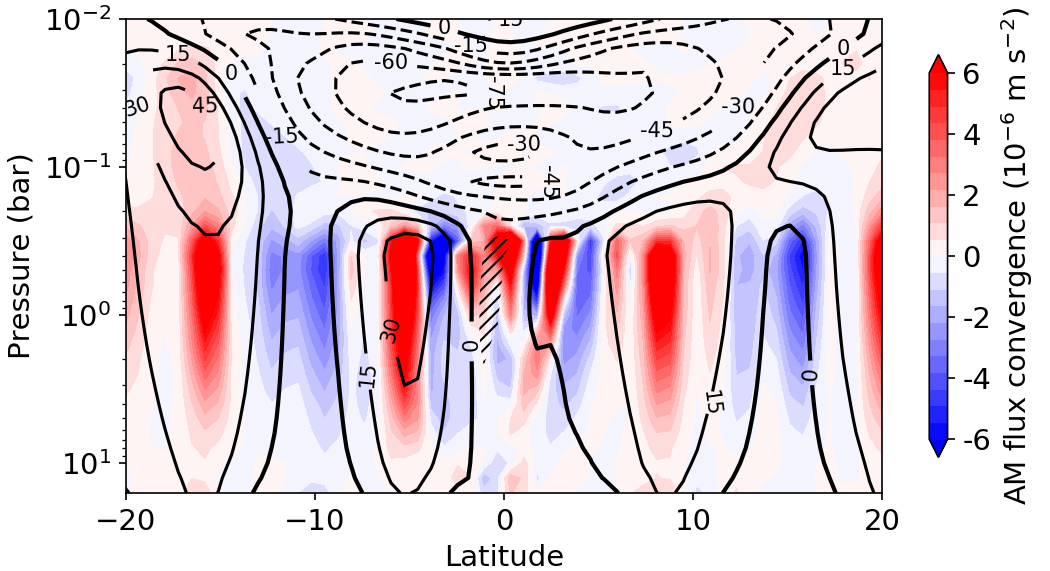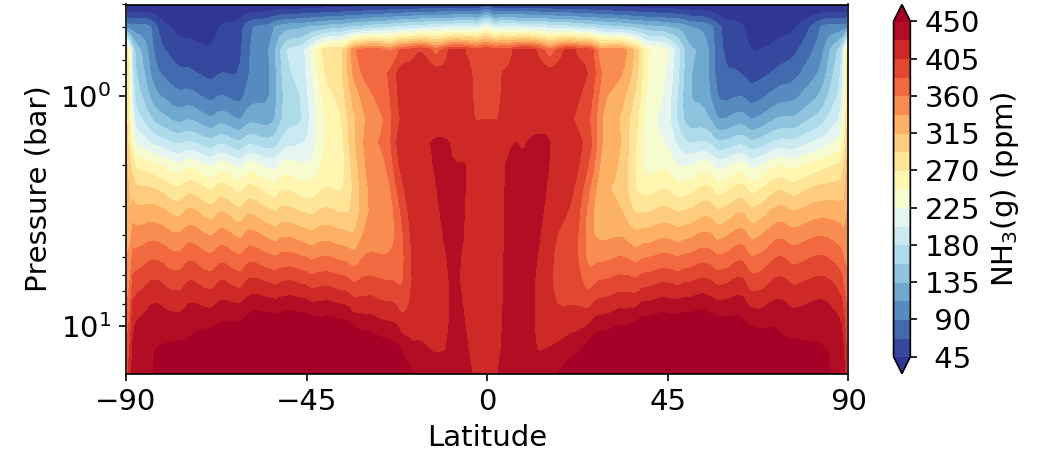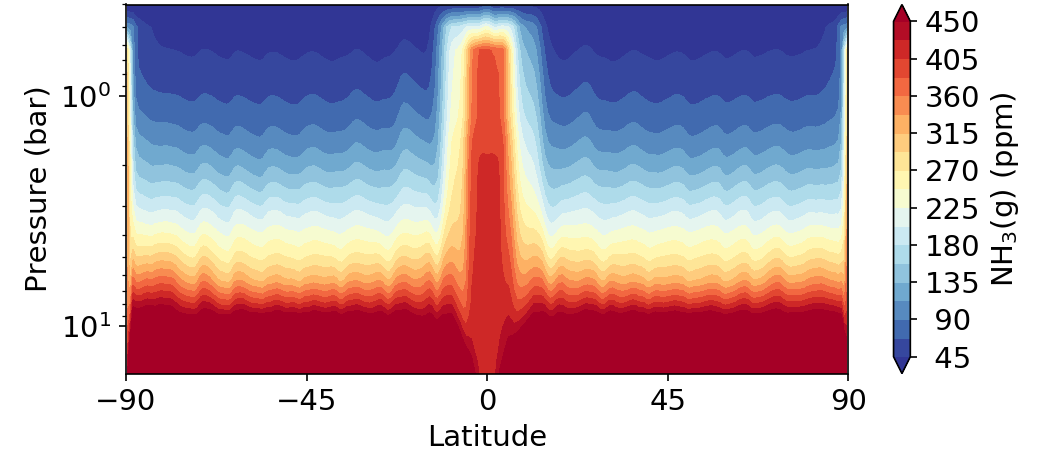Modelling Jupiter's atmosphere
Much of my work has been with a numerical simulation of Jupiter's atmosphere, which simulates the atmospheric circulation and climate in the troposphere and lower stratosphere of that planet. All four of the giant planets have no solid surface and so are different examples of rapidly-rotating, spherical balls of fluid, without many of the complications present in the Earth's atmosphere. Studying convection and turbulence on the giant planets helps us to understand these phenomena in the more complicated environment of our own planet.
I have used this model to study zonal jet formation (Young et al., 2018a), cloud dynamics (Young et al., 2018b), moist convection, stratospheric oscillations, turbulence at high resolution, and the global energy cycle (in prep.).
Movies showing simulations from the first two papers:
- Vertical velocity without interior heating.
- Relative vorticity with interior heating.
- Zonal jet spin-up with interior heating.
- Water ice column density with interior heating.
A dataset containing output from the simulations in the first two papers can be found at ORA-Data.
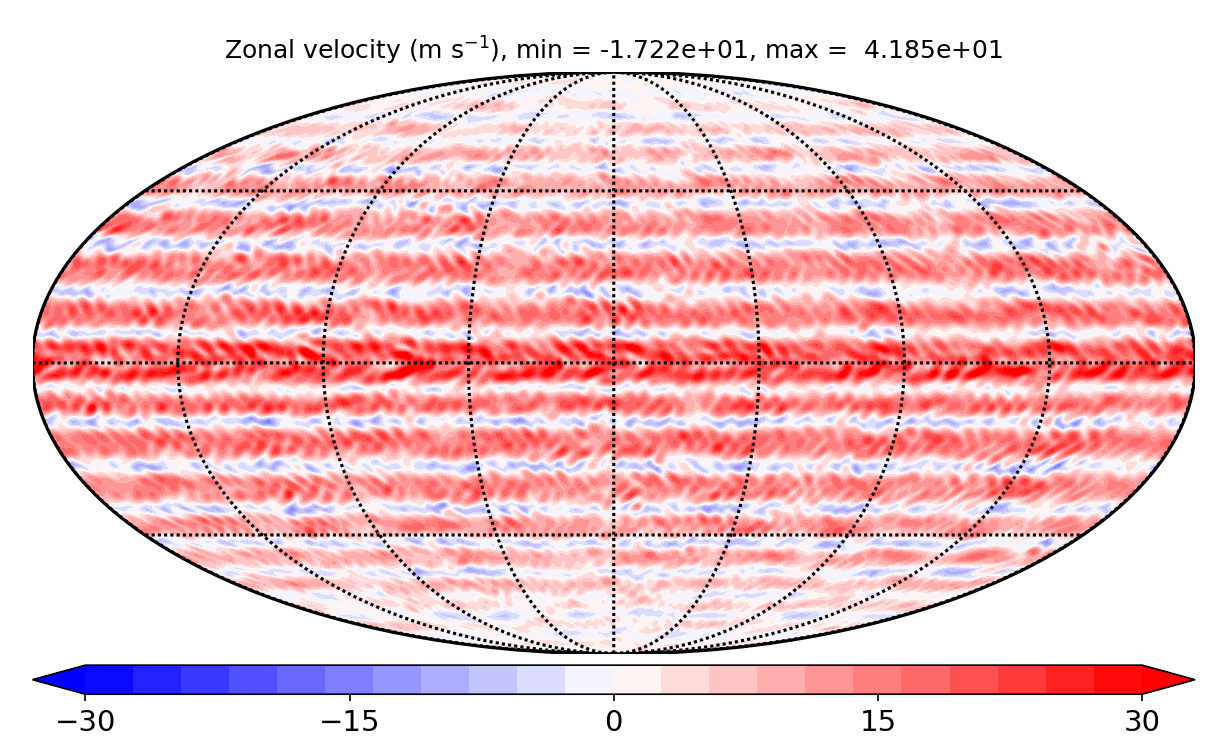
Model description
The model was initially adapted in the 1990s in Oxford from the UK Met Office Unified Model, and the current version is based on the MIT General Circulation Model. The model uses the MITgcm's atmosphere mode with parametrizations representing the most important processes in Jupiter's atmosphere. Most recently we have added the effects of latent heat, moist convection, and a two-band radiation scheme based on other work done in the group using the PUMA model. This helps us to understand better the physical mechanisms involved in processes such as the formation and maintenance of Jupiter's spectacular banded structure.
The early versions of the model used the Met Office UM as a limited-area general circulation model of the Jovian stratosphere and upper troposphere, using the HadAM3 core of the UM with simple parameterisations of
- Radiation balance using Newtonian cooling.
- Velocity damping effects via Rayleigh friction and a sponge layer at the upper boundary.
- Richardson number-based vertical diffusion.
- Dry convective adjustment based on the local vertical temperature gradient.
- Cloud evaporation / condensation / precipitation processes for the major cloud species on Jupiter (NH3, NH4SH, and H2O).
The current version of the model using the MITgcm has added to this
- A two-band (broadband shortwave/longwave) radiative transfer scheme, replacing the Newtonian cooling. This is forced by shortwave radiation from above (from the Sun), and longwave radiation from the planet's interior.
- A parametrization of linear drag at the bottom of the model domain, replacing the original forcing towards the observed zonal mean velocity profile, primarily to stabilize the model integration.
- Latent heating from phase changes of water.
- A parametrization of moist convection, including representations of updrafts and downdrafts, based on treating the atmosphere as a heat engine.
The model runs globally over 33 vertical levels between 18 bar and 0.01 bar. The typical horizontal resolution is a longitude-latitude grid with 512 x 256 points (0.7 degree) but we have also run it at 1024 x 512 (0.35 degree). Our simulations have used the Oxford ARCUS cluster, the STFC DiRAC consortium facilities COSMA5 and Darwin, and the Southampton University Iridis cluster.
Jet spin-up in a dry atmosphere
We investigated how the equatorial jet on Jupiter develops under two scenarios. In the first there was only atmospheric heating from the Sun, which heats 0.5-10.5 W m-2 depending on latitude. The second added 5.7 W m-2 heating from below, from the interior of the planet, which is a more realistic representation of Jupiter's atmosphere.
The simulations ran for 130000–150000 days to allow the deep atmosphere to come into radiative equilibrium. Baroclinic instability generated alternating, eddy-driven, midlatitude jets in both cases.
With interior heating the zonal jets migrated towards the equator and became barotropically unstable. This generated Rossby waves that radiated away from the equator, depositing westerly momentum there via eddy angular momentum flux convergence, which span up a super-rotating 20 m s−1 equatorial jet throughout the troposphere. There were 30–35 zonal jets with latitudinal separation comparable with the real planet, and there was strong eddy activity throughout.
Without interior heating the jets did not migrate and instead a divergent eddy angular momentum flux at the equator spun up a broad, 50 m s−1 sub-rotating equatorial jet with weak eddy activity at low latitudes.
(Young et al., 2018a, Fig. 25).
Cloud dynamics
We examined the ammonia and water cycles during spin-up of the zonal jets. Ammonia vapour changed phase to ice, and reacted with hydrogen sulphide to produce ammonium hydrosulphide. Water changed phases between vapour, liquid, and ice depending on local environmental conditions, although liquid water was very rare. All condensates sedimented at their respective Stokes velocities.
With interior heating, clouds of ammonia ice, ammonium hydrosulphide ice, and water ice formed with cloud bases around 0.4 bar, 1.5 bar, and 3 bar, respectively. Without interior heating the ammonia cloud base formed in the same way, but the ammonium hydrosulphide and water clouds sedimented to the bottom of the domain.
Shortly after initialisation, due to strong meridional mean circulation at the equator, the ammonia vapour distribution up to the cloud base resembled the enhanced concentration seen in Juno observations. This resemblance decayed rapidly over time, but it suggests that at least some of the relevant physics is captured by the model.

